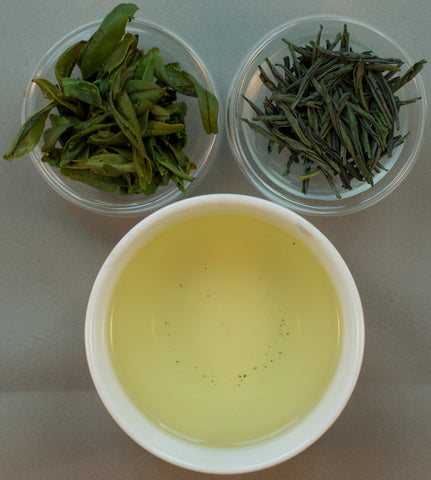The name Bi Luo Chun (碧螺春) literally means Green Snail Springtime and refers to the shaping of the leaves into tight bundles that resemble coiled snails, or snail shells. In its traditional green tea form from Dong Ting, Bi Luo Chun is one of China’s Ten Most Famous Teas.
I love to watch this tea unfurl in the water. It’s like it is alive; this movement is sometimes called the “agony of the leaves”. For best effect, I use a clear brewing vessel and add the tea to the hot water rather than the other way around. Then some of the tea stays on top and some goes to the bottom, while some moves back and forth as the air trapped in the rolled leaves is released.
Provenance:
-
Origin: Mojiang Town, Simao District, Pu'er Prefecture, Yunnan Province, China
-
Grower/Teamaster: Ya Family
-
Elevation: 1300 meters
-
Harvest Date: Early March 2023
-
Cultivar: Camellia Sinensis Assamica var. Yunkang #100
-
Cultivation: Conventional, No spray
-
Plucking Standard: Imperial/Pure Bud Pluck of first flush leaves
-
Processing Notes: brief withering, kill green frying, breaking, drying, then hand-rolled into tight snail-like balls, and dried
-
Nickname: Green Snail Springtime (云南单芽碧螺春)
-
History/Pedigree: Yun Kang #100 has been grown by the Ya Family on their plantation for about 25 years. Mr. Ya has been certified by Pu’er Prefectural authority as a High level (高级) tea processor.
Brewing Suggestions1:
-
Western Steep:
-
Water: 170-180˚F
-
Tea: 2g per 4oz of water (about a level 1/2 TB2)
-
Infusion: 2-3 infusions at 2 minutes each
-
Eastern/Gongfu
-
Water: 185-195˚F
-
Tea: 2-4g per 4oz of water (about a level 1/2 to 1 TB2)
-
Infusion: Flash rinse then 15 second 1st infusion; Add 15 seconds for each subsequent infusion until opened up and steeped out
Tasting Notes:
- Sweet, thick and vibrant. Slight astringency that counters the sweetness, lending it depth and complexity.
1 Brewing suggestions are just that. Try it the suggested way then experiment. Some tea drinkers like to use slightly hotter and longer times for each subsequent infusion.
2 Weighing your tea is always the best way to control your dosage. I provide approximate volume measures for convenience but they can be problematic due to the variance in tea leaf shape and size. It’s best to use the single appropriate volume measure for the tea, i.e., don’t try to measure 1.5TB using two spoons meant to measure 1 TB and a ½ TB. Use an actual 1.5 TB measuring spoon. Yes, they make them! I like the oblong ones to handle longer leaf styles.



